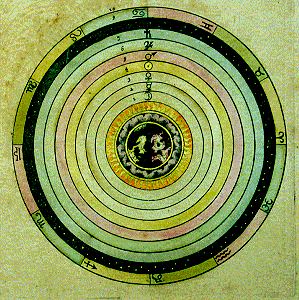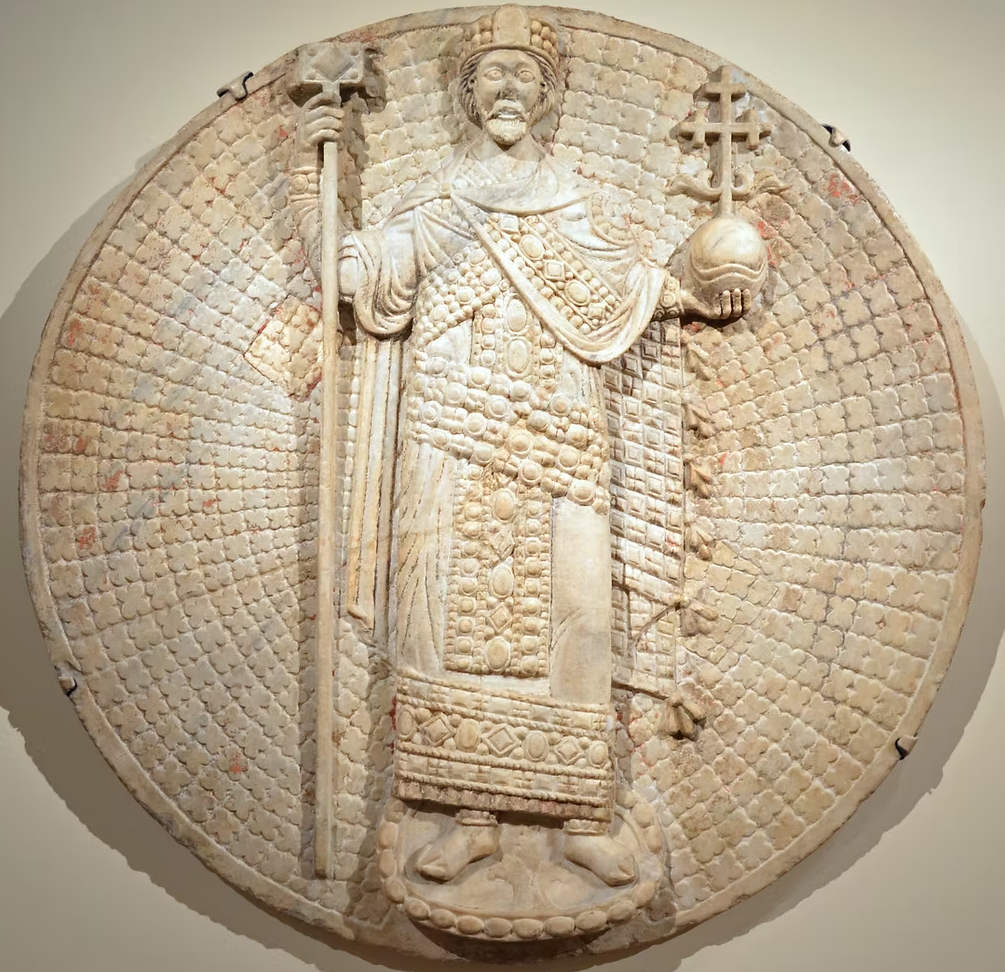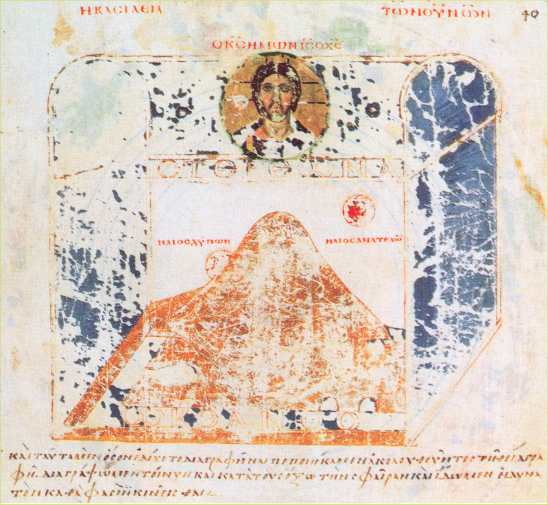|
These are good questions which need to be asked. A huge sphere
rotates with incredible rapidity around the earth. What force moves
it? Mustn't such a large object be incredibly massive? Well, it's made of the 'quintessence,' the fifth element not
found on the earth, so maybe it's something like gossamer wings and
moonbeams? But Cosmas' own system is certainly no improvement. He
proposes a large mountain in the north, which will produce the
appearance of sunset and solar eclipse when the sun hides behind the
mountain. He has pusher angels shoving the luminaries around; though for
that matter, so did Johannes Kepler. He realized the Ptolemaic system of astronomy can
successfully predict when eclipses will occur. His system cannot.
Although he claims there were flat-earthers who could predict
eclipses, I strongly suspect these people were using the Ptolemaic
system to predict the eclipses, which at least works, and not this
mess. To the trash bin it must go.
Cosmas also claimed his system was derived from the scriptures. On what possible basis? Where in the Bible is there any
system of flat-earth astronomy set forth? Why, in the description of
the tabernacle, of course. Moses gives detailed instructions for the
erection of a portable shrine, made of fabric and wood, collapsible
for easy transport. The table enclosed within is flat and
rectangular, as is in the nature of tables. This, according to Cosmas, is a scale model of the earth: "Moses, likewise, in
describing the table in the Tabernacle, which is an image of the
earth, ordered its length to be of two cubits, and its breadth of
one cubit." (Cosmas Indicopleustes, Book II, p. 31, The Christian
Topography of Cosmas Indicopleustes).
There's no hint in the Bible
that the tabernacle is intended to be a scale model of the cosmos. But
that is how we get Cosmas' flat earth: "He [God] then afterwards direct
him [Moses] to construct the Tabernacle according to the pattern which he had
seen in the mountain — being a pattern, so to say, of the whole world. He therefore made
the Tabernacle, designing that as far as possible it should be a
copy of the figure of the world. . ." (Cosmas Indicopleustes, Book
III, p. 110, The Christian Topography of Cosmas, an Egyptian Monk). The
text says that Moses should make the tabernacle after the pattern
shown him on the mount, not that the tabernacle should be the
pattern for the world! Where did that idea come from? In Cosmas' case, from an older monk,
but where did he get it from? It seems to have been an established idea of the old heathen
Egyptian religion that a shrine or a temple ought to be a simulacrum
of the cosmos, even though human-constructed buildings tend to be a bit boxy
(the temple of Vesta was a circular exception to the rule). The closest verse which an ambitious
heresiarch, mining the scriptures to find some hint of this pre-existing pagan
belief, hit upon is Hebrews 9:1: "Then verily the first
covenant had also ordinances of divine service, and a worldly
[κοσμικον] sanctuary." The word 'cosmikos' means 'worldly,'
'pertaining to this world,' not 'a scale model of the earth system' (in
Cosmas' scheme, it's only the flat table which represents the earth;
the candlestick gives us the luminaries). So you take a pagan idea, combine it with the
Bible, and then you get the earth as a rectangular plane so that it
can be modeled by a table. This isn't a case of finding a picture in the
Bible, but of importing it, indeed shoe-horning it in there.
Which of these two competing world views won the hearts and minds of Christendom?
According to the atheists, Cosmas' flat-earth system prevailed, driving
the Ptolemaic system underground for two hundred years: "Cosmas
Indicopleustes also attacked the doctrine with especial bitterness,
citing a passage from St. Luke to prove that antipodes are
theologically impossible. . .Under such pressure this scientific
truth seems to have disappeared for nearly two hundred years; but by
the eighth century the sphericity of the earth had come to be
generally accepted among the leaders of thought. . ." (Andrew D.
White, A History of the Warfare of Science and Theology, p. 132).
On the other side of the equation, all of three manuscript copies
exist of Cosmas' treatise. We are in the realm here of 'alternative facts.'
How influential a man was Cosmas? He is quoted
hardly at all, other than dismissively by Photius.
The best that can be said of Andrew Dickson White is that he was the
kind of person who could not bring himself to believe that anyone
who held views differing from his own could be honest, brave and
true, and that inventing facts and circumstances tending to preserve
this conviction was worth the freight.
Compare the three extant copies of Cosmas' magnum opus with the
hundreds of surviving manuscript copies of John of Hollywood's
(Johannes de Sacrobosco) thirteenth century treatise, "On the
Sphere of the World (De sphaera mundi)." John's textbook
is essentially an introduction to the Ptolemaic system. Counting up
manuscripts, it is difficult to award Cosmas the prize for winning
the debate, but that is just what some people want to do.
Surely the mere articulation of Cosmas' view cannot suffice for proof that it overturned
the established round earth consensus. Flat-earth cosmology is upheld in
the present day by a society which ascribes the space program to Hollywood
special effects. Yet no one takes this to demonstrate that people in the
twenty-first century are flat-earthers! The claim by the nay-sayers that
the early Christians believed in a flat earth is based on these two
guys,— count 'em, two,— Cosmas Indicopleustes, not
otherwise known, and Lactantius, a fourth century Latin rhetorician:
"In the sixth century this development culminated in what was
nothing less than a complete and detailed system of the universe,
claiming to be based upon Scripture, its author being the Egyptian
monk Cosmas Indicopleustes. Egypt was a great treasure-house of
theologic thought to various religions of antiquity, and Cosmas
appears to have urged upon the early Church this Egyptian idea of
the construction of the world, just as another Egyptian
ecclesiastic, Athanasius, urged upon the Church the Egyptian idea of
a triune deity ruling the world. According to Cosmas, the earth is a
parallelogram, flat and surrounded by four seas." (Andrew D. White,
The History of Warfare of Science with Theology, p. 122). Where in scripture is
found the plan of the earth as a parallelogram? Well, it isn't
there, of course, unless you count the flat table in the tabernacle. Rather,
even this anti-Christian author realizes the scheme
was based on a pre-existing pagan Egyptian concept. Why this revival of
Egyptian paganism proves the early church believed in a flat earth, he doesn't say.
Where did Cosmas go wrong? He elicited from round-earth astronomy
a testable prediction: that the torrid zone is uninhabitable. They
did make this prediction. He then proceeded to test this prediction,
by travelling to a locale in the torrid zone. And what did he find
there? People! So round-earth astronomy is disconfirmed, right? No,
because we're going to start moving the goal-posts. In fact this
idea of an uninhabitable torrid zone is not essential or inherent in
round-earthism. The best way to salvage round-earthism is just to
drop it.
Why did Parmenides find this an attractive idea in the first
place, that the torrid zone was uninhabitable by reason by heat? We can only speculate.
Perhaps, realizing that if you travelled south from Libya, you
were stopped dead in your tracks by a hot, waterless, trackless
desert, the Sahara, he over-generalized and explained that deserted sandy
waste by proximity to the torrid zone. It is striking that, when you
look at a map with topographic zones marked by different colors,
there is nearly a continent-wide desert across Africa, and then
a desert takes up most of the Arabian peninsula. Certainly, they
must have realized, things are not so to the north of Greece; Europe
is green.
Even in the absence of human habitation, the leeward side of
mountain chains tends to be dry, as the peaks wring the rain out of
the moisture-laden air blowing across them. The American plains must
have been dry before they were peopled, on account of the Rocky
Mountains. The Atlas mountains likely left an arid 'shadow' before
there was any human being swimming in the rivers of the Sahara, as
they then ran. But continent-wide? Every year we see human beings
extend the Sahara, even to the present day, by over-intensive
agriculture and overgrazing goats. Realizing they've been doing so
for millenia, that could explain how a small natural desert grew
immense. Just as beavers are the wetlands-producing animals, perhaps
we are the desert-producing creatures, assiduously terra-forming
green parklands into sand deserts. Perhaps this tell-tale tan blot
expanding on the map tells the story of where we've been. But
Parmenides must have realized the Alps leave no dry wasteland in
their shadow. Perhaps it's the heat in the torrid zone? A plausible
conjecture led to over-generalization, because some areas round
about the equator are rain-forests, lush green jungles, not deserts.
The mystery really is why
people were still telling Cosmas, in the sixth century A.D., even
dinning it into his ears, that he
was wasting his time trying to travel to India because much of
southern India is in the torrid zone. Why didn't they know better by
then? Modern science has achieved a ratcheting effect, where things
discovered tend not to be undiscovered, but ancient science never
quite got there. Although perhaps by now we have discovered the undo
button, as flat-earthism takes over YouTube.
|



